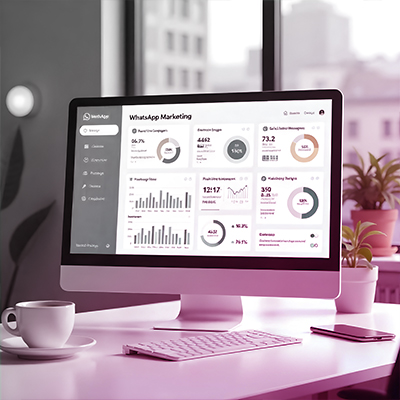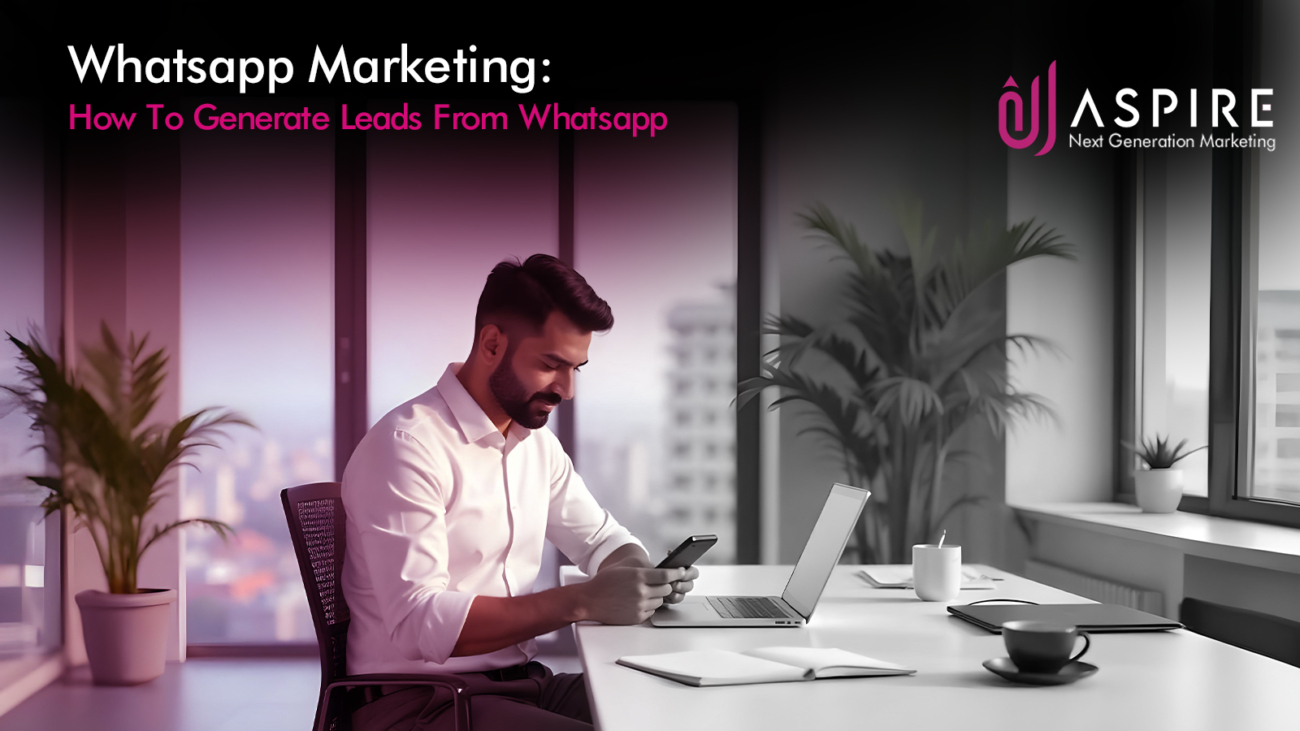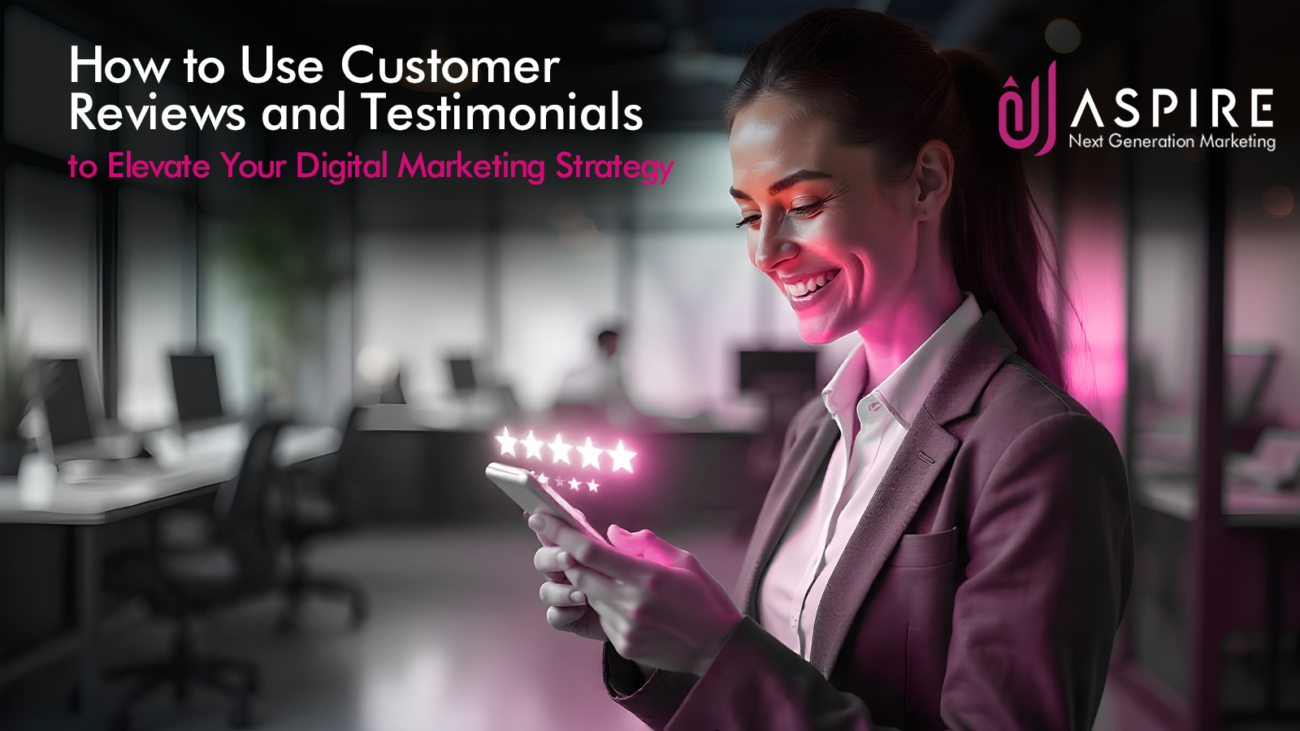WhatsApp Marketing is one of the most significant strategies for setting business connectivity with the target audience in this fast-changing digital marketing environment. From over 2 billion global active users, WhatsApp has progressed from a simple chatting buddy with friends and family to a potent tool for customer engagement that creates leads and takes businesses closer to growth.
Let’s discuss how WhatsApp Marketing can be your lead generation tool and guide you through setting it up along with sharing actionable strategies and some key metrics to check its success. At the end of this guide, you will have learned common mistakes to avoid and how the leading digital marketing agency, Aspire Digital Media, can help you tap into WhatsApp’s power to grow your business.
Table of Contents
Why Choose WhatsApp for Lead Generation?
Let’s dig deeper into WhatsApp Marketing first. Let’s try to understand why WhatsApp marketing is so effective in creating leads.
Brand Awareness
WhatsApp has a following that cuts across all the continents of the world and crosses most demographics. It is one of the most inclusive means to get the word out to leads regardless of location.
High rates of engagement
WhatsApp messages have an open rate of more than 90%, which is way beyond other communication channels such as email. Most messages are read in minutes, making it an ideal platform for timely engagement.
Personalized Communication
Unlike the usual one-size-fits-all campaigns, WhatsApp Marketing provides businesses with the ability to create personalized, direct, and personal communications with potential leads. This personal touch creates trust, which increases the chances of conversion.
Capability of Multimedia
With text, images, videos, documents, and voice notes, WhatsApp allows unlimited scope to share interesting content with great visuals.
Cost-Effective Marketing
WhatsApp Marketing is way too economical compared to the traditional methods of marketing. It’s especially best suited for small businesses and for start-ups looking to leverage their marketing budget.
Automation and Scalability
This way, through WhatsApp Business and API, you will automatically send back replies, distribute bulk messages, and even connect the app to CRM solutions. All these features make the platform rather scalable for any kind of business.
Setting Up WhatsApp Marketing
WhatsApp Marketing is easy to start, but information that is too broad and lacking detail will not bring out the real worth of it. Setup should be proper in order for marketing to be smooth, professional, and effective.

Enable WhatsApp Business
If you’re currently using a personal WhatsApp account, upgrade to the WhatsApp Business app. This specialized app is designed specifically for businesses and offers features that enhance customer engagement and communication. Key features include:
- Automated greetings to welcome a new customer.
- Fast answers to the most repeated questions.
- Labels for organization and easy contact.
- Primary analytics for tracking the performances of your messages and knowing users’ behavior.
- Using the features listed above, enterprises will streamline their conversations and bring a professional touch to business presentations.
Craft a Professional Business Profile
Your WhatsApp profile is essentially the first impression before potential leads, so it has to look professional and inviting. Ensure that the following are included in your profile:
- Professional logo or profile picture that represents your brand identity.
- Your business name and short yet more exciting description
- Updated contact information including phone number, email, and address
- Operating hours so as to set clear expectations with communication.
- A well-optimized profile builds credibility and helps you earn trust with your audience.
WhatsApp API Integration
WhatsApp API integration into the system should be done, especially for medium and large businesses. It is an advanced tool that allows:
- Sending mass messages to a large audience without losing personalization.
- Multiple user accounts for efficient communication across teams.
- Syncing with the CRM system for better lead management.
- This scalability can be achieved by integrating it with WhatsApp API which automates the process, saving one both time and resources while staying efficient.
Opt-In Subscriber List
Ethical audiences are the core of successful WhatsApp Marketing. Obtain telephone numbers legally and have users opt into your updates. Here is how to do it:
- Use signup forms on your website to push WhatsApp subscriptions.
- Invite followers from social media to join your list of WhatsApp subscribers.
- Ensure that you attach a call-to-action button when you send an email to them, so they can connect with you on WhatsApp.
- Give them exclusives; provide useful resources or freebies to get people excited and subscribe to your list.
- Using opt-in mailing lists helps in adhering to data privacy laws while also gathering a loyal group of leads very eager on your offering.
- The WhatsApp Marketing framework is set up in a very intentional way, and the right structuralization of the framework enables efficient customer communication that can amplify the impact of the communications.
Strategies to Generate Leads from WhatsApp
Strategy now, after creating an account, would attract, feed, and convert leads through WhatsApp Marketing. This would connect marketers with their audiences on a different level altogether, in terms of interaction.
Build interest groups
WhatsApp groups help your business in creating a community in which businesses can have direct associations with their potential leads. To do so, create groups based on niches or interests related to your product or service, and start sharing valuable information, limited offers, and regular news updates in the group. Through questions, polls, or a feedback channel, encourage those in your group to start participating more actively. One well-organized group helps in making a hub through which the brand can be molded and created.
Run paid Ad campaigns
Click-to-WhatsApp is now allowed through platforms like Facebook and Instagram. Through these ads, users can directly start a conversation with your business on WhatsApp. Thus, these do make the generation of leads quite smooth. Use interesting ad copy, visuals, and clear calls to action to make these campaigns effective. Combine them with retargeting strategies for the users who have interacted with your brand before.
Status on WhatsApp
The Status feature on WhatsApp is the ultimate treasure trove for telling and flashing updates of your business, customer testimonials, product demos, and time-sensitive offers. Since statuses delete themselves after 24 hours, this creates urgency that forces people to act sooner than they usually would. Make those statuses more appealing using attractive visuals or videos.
Specifically Craft Messages
Generic messages hardly have any impact. Use customer names and further segment your audience based on the demographic, preferences, or past interactions to have those messages personalized. Personalized messages on birthdays, anniversaries, or the occasions can leave the audience with that feeling. A message becomes more authentic and real while being well-personalized, which raises the chance that it will be engaged.
Offer Incentives
Entice potential leads by offering exclusivity incentives, such as having WhatsApp-only discounts or freebies, or new product access. When you are promoting your channel on WhatsApp, highlight the fun and benefits of being part of your community. For example, give a one-time coupon code good only for a short period of time for users joining your broadcast list or group.
Hosting webinars and live events
Use WhatsApp to promote your webinars, Q&A sessions, or live launches of new products. Share links for registration, reminders, and even exclusive content after the event on WhatsApp. Such engagement with the audience calls in leads and improves the brand’s status as an authority in its niche. Follow up with the attendees for feedback and further interest.
Information-sharing material
Consistently deliver value by sharing informative content such as how-to guides, industry insights, or actionable tips. This positions your brand as a go-to resource within your industry. For example, if you’re in the fitness industry, sharing weekly workout plans or nutrition tips can keep your audience engaged and coming back for more.
Provide excellent customer services
Provide immediate support through WhatsApp. You can provide instant responses to customers about their queries and complaints while designing custom solutions at a fast pace. If the prospects get immediate efficient responses, then they do believe in your brand. More so, satisfied customers refer people to you as well; it increases your lead base organically.
Activate WhatsApp Broadcast List
Broadcast lists enable you to send messages to large audiences without violating their privacy. This feature is great for sharing updates, exclusive promotions, or festive greetings across a large audience. Keep them relevant by segmenting your broadcast lists based on preferences followed by content that appeals to their needs.
Using Multimedia Content
Use videos, infographics, gifs, or voice notes to create multimedia messages. A short product demo video can explain the features and benefits better than any text. Multimedia messages attract the eye and induce engagement. Thus they will become part of your WhatsApp Marketing strategy. With thoughtful implementations of WhatsApp Marketing, eventually, you will flourish with a good number of quality leads and long-term relationships with customers. All you need to do is experiment to refine what works best for your audience.
Key Metrics for WhatsApp Marketing
This would track performance in terms of continuous improvement of WhatsApp Marketing campaigns and ensuring that efforts produce the sought outcome for your business, according to goals set. Tracking such metrics would be imperative to perfect the strategy in terms of maximizing engagement and thus improving results going forward.

Message open rate
The open rate is the rate of how many recipients viewed your messages. With high open rates of WhatsApp, tracking this metric determines whether your content is capturing the attention of the audience. High open rates mean that the audience finds your messages relevant and engaging, and low rates might suggest the need for more engaging content or better timing.
Response Rate
It is the response rate of the recipients to your messages. A large response rate means the audience is very interested in the message, and the communication has been effective. This means your messages strike a chord with your audience who are interested in interacting. Improve it: Clear call-to-actions and keep your messages conversational.
Conversion Rate
The conversion rate tells the number of leads that take action with your messages. This could mean them purchasing something, getting a service, or downloading an e-book and event registration. A high conversion rate, therefore means that the efforts placed in WhatsApp Marketing are actually tangible; it can guide the lead through the sales funnel.
Consumer retention rate
Retention rate indicates how many users remain subscribed to your WhatsApp updates over time. A low churn rate suggests that your content consistently adds value and keeps your audience engaged. Regularly analyze this metric to ensure you’re providing relevant and meaningful updates that encourage long-term loyalty.
Click-through rate (CTR)
This measurement helps analyze how many users have clicked on the links when available for campaigns. Good CTR implies that calls-to-action are clear and persuasive to customers. Work on visually attractive messages and have links open onto landing pages that hold some value to the visitor, so CTR may increase.
Common Mistakes to Avoid in WhatsApp Marketing
With WhatsApp Marketing, though highly potential, a simple mistake will kill the chances and integrity of your campaign. To make things easier, read this article and don’t fall into some common mistakes.
Spammer
Sending too many messages to your audience will very quickly be frustrating and disengaging for them. Overloading the recipient may even lead to blocked numbers, unsubscribes, or even legal implications in case of spam complaints. Focus on relevant, timely content rather than sending multiple updates to the audience. Quality will always supersede quantity.
Overlook Personalization
Generic, one-size-fits-all just don’t cut it in WhatsApp. Often, such a generic message flops or gets no engagements at all because nobody understands it; tailor your content to suit meeting and solving your audience’s particular preference, need, and pain point. Use segmentation for customized messages that resonate and create an idea of attachment.
Opt-In Ignorance
Adding violators of privacy regulations such as the GDPR into your contact list harms your brand too. Trust forms the basis of good WhatsApp marketing. Always ensure that your target audience has opted into a willingness to be heard by you. Sometimes, clear value propositions make users willingly subscribe to your list.
Latency Response
With the instant messaging purpose, the user expects a prompt reply. Delayed responses will infuriate potential leads who lose interest or go elsewhere. Automated reply settings should be able to immediately acknowledge queries but then mean that your team is ready to respond appropriately during business hours.
Analytics Missing
Campaign performance may also be an opportunity missed for improvement if it is not monitored or analyzed. Among the usual metrics that are very useful in helping know what is working and what is not, are rates of opening the messages, responses, and conversions. Review your data periodically to fine-tune your strategies so that efforts align with your goals.
Using jargon or improper language
WhatsApp is a really informal channel, though. But here too, professionalism is to be observed. Speak professionally. Avoid slangs and all other unprofessional expressions that could discredit the brand or simply fail to impress your leads. Strive for clarity, politeness, and professionalism in every single word.
Underestimation of Multimedia Power
This makes communication with them sometimes monotonous and less engaging if only text-based messages are utilized. Multimedia content, videos, images, or voice notes present opportunities often missed to get one’s attention. Use visual and audio elements strategically to make your messages more productive. These are the mistakes you would avoid, hence making your WhatsApp Marketing campaign successful and helping you create long-term relationships with your audience. In simple words, it is respect for user preference, provision of value consistently, and always trying to get better.
Conclusion
WhatsApp Marketing will surely change how you carry leads and increase your business. High engagement rates, mass outreach, and personal touch make it one of the most popular marketing tools for marketers working in diverse industries. All this can be further amplified when you set up a professional account, strategically implement campaigns, and track key metrics.
For the next level in WhatsApp Marketing, find a partner in Aspire Digital Media, one of the best digital marketing agencies. It gives you customized marketing solutions based on your business needs. Expert guidance and innovative strategies help you harness the potential of WhatsApp Marketing to get really impressive results.
Ready to Get Started? Join Aspire today to begin WhatsApp marketing now and let business pick up!
Read more: How to Use Customer Reviews and Testimonials to Elevate Your Digital Marketing Strategy
FAQ
Do I need a WhatsApp Business account to generate leads?
Indeed, this is an important lead generator; the WhatsApp Business account allows services like auto-response, labels for categorizing contacts, and business profiles, which will make conversations professional and efficient. For more elaborate campaigns, integration with the WhatsApp API is best for getting advanced functionalities.
Can I use a WhatsApp chatbot for lead generation?
Absolutely! A WhatsApp bot could automate lead qualification, respond to FAQs, and guide through a sales funnel. One also gets 24/7 accessibility and the user experiences, as he gets replies on the instant, increase the engagement and conversions.
What are the best practices for engaging new leads on WhatsApp?
– Personalize messages with names and preferences.
– Provide value through informative content or offers.
– Respond promptly to questions.
– Do not spam; keep communication regular but respectful. Use multimedia, such as videos or images, to add interest to messages.











